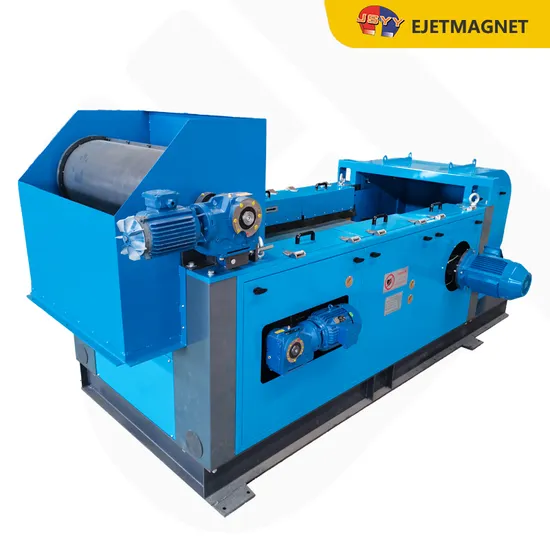
Excellent Quality Eddy Current Separator for Recycle Pet Water Bottles Plastic Flakes
Basic Info.
Model NO.
ECS
Material Processed
Plastic Flakes
Plastic Type
PET
Screw
Metal Recycling
Automation
Automation
Computerized
Non-Computerized
Certification
CE, SGS
Recovery Rate
98.5 - 99.5 %
Processing Capacity
0-12ton/Hour
Dimension(L*W*H)
3670X2000X1285mm
Motor
Nord
Belt
Forbo Siegling
Bearing
NSK
Reducer
Schneider
Power
5.5+3.0+0.55*2(Kw)
Eddy Current Separator Belt
Forbo Siegling
Product Keywords
Nonferrous Separators
Size Nonferrous Metal Separation
Custom Size
Application
Nonferrous Metal Separation
Features
Non-Ferrous Metal Recovery
Installation
Engineer Guidance
Feeding Size
≥3mm
Transport Package
Export Packing
Specification
magnetic separator recycling machine
Trademark
JSYY
Origin
Fushun, Liaoning, China
HS Code
85051190
Production Capacity
50sets/Month
Packaging & Delivery
Package Size
420.00cm * 350.00cm * 130.00cm
Package Gross Weight
4000.000kg
Product Description
Application of eddy current non-ferrous metal separator
1. Recovery Of Non-ferrous Metals From Waste Materials.
Separation of ferrous and non-ferrous metals in Shredded End-of-Life vehicle/cars (ELVs) & auto shredder residue(ASR)recycling industry
Ferrous and non-ferrous metals recovery from shredded End-of-Life domestic application
Aluminum recovery from shredded and pre-treated co-mingle recyclables metal (Zorba) recycling industry
Recovery of non-ferrous metals from slag after the incineration of municipal waste.
steel slag scraps recycling industry
crushed Bulky City waste recycling
non-ferrous dross recovery from foundry sand in aluminum-shell-sand recycling lines.
non-ferrous recovery in Waste Electrical and Electronic Equipment(WEEE) recycling plants
non-ferrous scrap from crushed waste electrolytic capacitors
2. Separation Of Non-ferrous Metals From Recyclable Materials.
non-ferrous scraps separation from cullet in glass recycling
aluminum scraps separation in UPVC window recycling.
non-ferrous components (such as brass rivets and hinges) separation in the timber recycling industry.
non-ferrous scraps separation in the plastic recycling industry
Non-ferrous scraps are separated from crushed rubber.
Aluminum cans sorted from municipal solid waste
FAQ
Q: What kind of metal is magnetic eddy current applied to?
A: suitable for crushed mixed metal scraps sorting industries
often the mixture is composed of steel, iron, etc ferromagnetic metal and aluminum, copper, and brass. etc non-ferrous scraps separation from materials of size >3mm.
Q: Which type should I use for my recycling plant?
A: In order to recommend the most suitable model, please let us know the material`s situation .including the composition, size, handling capacity and expected separation result.
Q: What are the pros and cons of a concentric pole rotor compared with and eccentric rotor design?
A: The eccentric type is much more suitable for the complicated material situation, The eccentric rotor design reduces long-term wear due to heated ferrous build up, and can effectively avoid the device damage caused by impurity ferrous metal.
Exclusive the ferrous influence, the concentric type has a little bit better separation effect but must make sure no ferrous exist.
For any inquire about various metal solutions, please feel free to contact with us
>> 9 Spline High Torque DC Motor Bi-Direcetional Motor
>> Jutu 500*1000 Coated PVC Tarpaulin Waterproof Tent Polyester Vinyl with ISO9001-2008
>> Chinese Manufacturer Supplier of LED Bulb G45 3W B22 Low Power LED Light Bulb with CE RoHS Certificate IC Driver
>> Booster Pump for RO Reverse Osmosis Pump
>> WEIKA Home Simple Design Aluminium Double Glazed Slide Aluminum Frame Glass Sliding Chocolate Windows
>> Premium Ferrosilicon FeSi65, 70, 72, 75 for High-Performance Casting
>> Post-Modern Creative Fashion Smoky Glass Pendant Light LED Luxury LED Chandelier for Stair Living Room Lt021
>> 6 Teeth Assemble Assembly Segmented Shredder Crusher Crushing Knife for Rubber Tire Tyre
>> 18 Inches Natural Wave Straight Middle Length Lace Front Wig in Purple Color
>> Car intake grille for vw Golf 7 GTI Auto parts Front grille OEM 5G0 853 651 K
>> Wholesale Engraved Laser Keyring Sublimation Key Holder Luxury Keychain with Logo Personalized Logo Blank Custom Wood Keychain
>> Iron Stair Railings Metal Balustrade Forging Spinning Machine
>> Copper Calcium Master Alloy Cuca20 Ingots Manufacturer
>> Plastic Injection Molding Machine/Injection Machine for Plastic Product
>> Weldon Shop windbreaker stand outdoor restaurant banners branded cafe breeze barriers
>> 600kg 8PCS Suction Cups Sheet Metal Panel Vacuum Lifter Suction Cup Lifter with CE
>> Wear-Resistant High-Temperature Rubber Ring Oil-Resistant Rubber Ring O-Ring Seal Ring
>> Portable Cheap Metal CNC Milling Machine 6060 4040 Engraving Nameplate
>> Pet Bottle Blow Moulding Machine
>> Three-Phase Fire-Resistant Resin Insulated Dry Transformer High Efficiency
>> Metal Ring Mesh Architectural Brass Color Metal Mesh
>> New Arrival Wireless Charger 10W 3 in 1 mobile phone Wireless Charging Adapter For iPhone, Airpods iWatch Pro
>> 8m Mini Electric Boom Cherry Picker Vertical Platform Lift
>> IBM Injection Blow Molding Machine
>> Four-Axis Linkage Control High Efficiency Wire Cut EDM Machine Dk7725
>> Wood Floor Sander Wide Belt Sanding Machine
>> Corrosion Resistance Plastic Rubber Lining Centrifuge Machine for Chemical Dye Industry
>> Stainless Steel Mixer for Medical/Food/Hot Melt Glue
>> Tortilla Packaging Automatic Food with A Thermal Noodle Sauce Sachet Bread Doypack Packing Machine
>> Metal fish tape, cable puller ,duct rodder